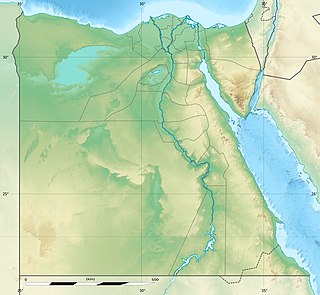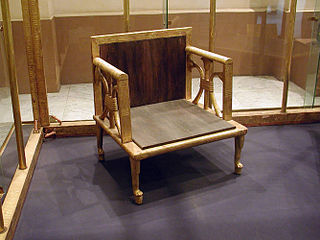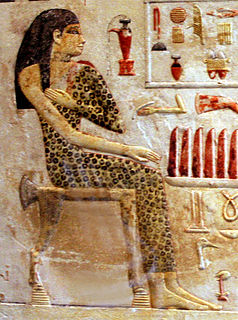
The Giza pyramid complex, also called the Giza Necropolis, is the site on the Giza Plateau in Greater Cairo, Egypt that includes the Great Pyramid of Giza, the Pyramid of Khafre, and the Pyramid of Menkaure, along with their associated pyramid complexes and the Great Sphinx of Giza. All were built during the Fourth Dynasty of the Old Kingdom of Ancient Egypt. The site also includes several cemeteries and the remains of a workers' village.

Hetepheres I was a Queen of Egypt during the Fourth Dynasty of Egypt.

Prince Ankhhaf was an Egyptian prince and served as vizier and overseer of works to the Pharaoh Khufu, who was Ankhhaf's half-brother. He lived during Egypt's 4th Dynasty.

Nefertiabet was an ancient Egyptian princess of the 4th Dynasty. She was possibly a daughter of Pharaoh Khufu.
Minkhaf I was an ancient Egyptian prince of the 4th Dynasty. He was a son of Pharaoh Khufu, half-brother of Pharaoh Djedefre and elder brother of Pharaoh Khafra. His mother may have been Queen Henutsen. Minkhaf had a wife and at least one son, but their names are not known.
Meritites I was an ancient Egyptian queen of the 4th Dynasty. Her name means "Beloved of her Father". Several of her titles are known from a stela found at Giza. She was buried in the middle Queen’s Pyramid in Giza.

Kawab is the name of an ancient Egyptian prince of the 4th Dynasty. He was the eldest son of King Khufu and Queen Meritites I. Kawab served as vizier and was buried in the double mastaba G 7110 - 7120 in the east field which is part of the Giza Necropolis.
Khufukhaf I was an ancient Egyptian prince and vizier of the 4th Dynasty.
Nefertkau I was a 4th Dynasty princess of ancient Egypt. She was the eldest daughter of King Sneferu and hence a half-sister to King Khufu. She was the mother of Nefermaat II and the grandmother of Sneferukhaf.
Nefermaat II was a member of the Egyptian royal family during the 4th Dynasty and vizier of Khafra.
Kaemsekhem was an ancient Egyptian nobleman and probably the son of Crown Prince Kawab and Hetepheres II. He later served as the director of the royal palace. He was buried in mastaba G 7660 in the Giza East Field, which is part of the Giza Necropolis.

Meresankh II was a Queen of Egypt who lived during 4th Dynasty.

Meritites II or Meritites A was a 4th Dynasty Princess of Ancient Egypt, and probably a daughter of King Khufu. She may have been a daughter of Meritites I based on the fact that this queen is mentioned in mastaba G 7650. She married the Director of the Palace Akhethotep and she had several children with her husband. Meritites and her husband shared a mastaba G 7650 in Giza.
Persenet was an ancient Egyptian queen consort of the 4th dynasty. She may have been a daughter of King Khufu and a wife of King Khafra. She is mainly known from her tomb at Giza.
Nefertkau II was an Ancient Egyptian noble lady, the wife of Prince Khufukhaf I, son of pharaoh Khufu.
Iynefer II was an ancient Egyptian prince, likely a son of Pharaoh Khufu. He was named after his uncle Iynefer I. Iynefer II’s wife was Nefertkau III; she was likely his niece, and they had one son and one daughter, Nefertkau. Both Iynefer and his wife are buried in the mastaba G 7820 at Giza.

The East Field is located to the east of the Great Pyramid of Giza and contains cemetery G 7000. This cemetery was a burial place for some of the family members of Khufu. The cemetery also includes mastabas from tenants and priests of the pyramids dated to the 5th and 6th Dynasty.

Cemetery GIS is a necropolis in the Giza Plateau. It derives its name from its proximity to pyramid G I (Khufu). The tombs are located on the south side of that pyramid and hence the name G I South Cemetery. Reisner thought the cemetery a continuation of the G7000 cemetery which is part of the Giza East Field. The construction postdates that of mastaba G 7070 of Sneferukhaf. Junker dated the cemetery to the reign of Menkaure based on the presence of granite powder thought to derive from the dressing of the second pyramid at Giza. Reisner allows for a possible construction date dating to the reign of Khafre.
Djaty I was a prince who lived in the ancient Egypt during the 4th Dynasty. He was an overseer of a royal expedition.
Idu was an official during the Sixth Dynasty, buried in Giza East Field, tomb G7102. He probably lived and served during the reign of Pepi I Meryre. He is the father of Qar whose tomb is nearby and Bendjet, buried in G7215.








